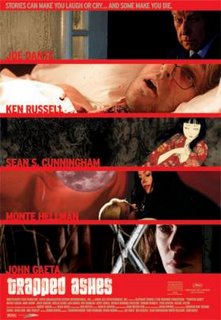TIFF 2006: "TRAPPED ASHES"
 (Midnight Madness)
(Midnight Madness)
USA/Japan, 104 minutes, 2006
Written by: Dennis Bartok
Directed by: Sean S. Cunningham, Joe Dante, John Gaeta, Monte Hellman, Ken Russell,
Cast: Lara Harris, Michele-Barbara Pelletier, Tygh Runyan, John Saxon, Rachel Veltri, Henry Gibson
This horror anthology came out under the radar and from across the pond: it’s a Japanese funded production that manages to pull off what was long-promised to any loyal reader of Fangoria’s Terror Teletype but never realized: to gather the cream of genre talent for a feature-length omnibus (Carpenter, Cronenberg, Craven, Fincher were all due to unite for one combo or the other—only “Two Evil Eyes” came close by teaming Romero with Argento, and Showtime’s “Body Bags” had Carpenter aided by Tobe Hooper, Yuzna had something, too, as I recall…). Check out this pedigree of talent: Sean S. Cunningham, Joe Dante, Monte Hellman, Ken Russell, and acclaimed special-effect maestro John Gaeta. Can’t go wrong, right? Well…
Unlike most horror anthologies, this one isn’t based on any known source material (E.C. Comics, Stephen King, 80s “Splatterpunk”) but rather an original screenplay by Dennis Bartok (a first-timer, which makes the project’s genesis all the more amazing). While Bartok demonstrates more fanboy passion than imagination, he clearly possesses a supernatural ability to attract talent. Too bad his yarns fail to deliver on the essential frissons, blowing the opportunity for a Japanese/American “4 Extremes”.
Joe Dante doesn’t get a chance to top his audacious “Homecoming” segment from last season’s “Masters Of Horror”—instead, he’s saddled with the thankless wraparound story, in which he at least gets to riff on the B-pic lore he knows intimately (too bad the Dick Miller cameo is the only opportunity he gets to acknowledge his days with Corman). An elderly tour guide (Gibson) leads six VIP guests into a haunted house set on the abandoned Ultra Studios backlot, where the late schlockmeister Desmond Hacker shot his many notorious shockers. They find themselves trapped in an octaganal room like the one in Hacker's most famous film "Hysteria," which apparently allows no exit from within its Escheresque geometry. Gibson suggests to the frightened tourists that since the characters in the film confessed their own real-life terror tales in order to escape, they should do the same…
Pneumatic blond actress Phoebe (Veltri) is up first—rather, up front first, by starting with a familiar tale of woe in “The Girl With The Golden Breasts”. She was once just another aspiring actress, schlumping from audition to audition, repeatedly passed over for roles due to her modest endowments. After she springs for a boob job, her career takes off, but when her boyfriend wakes up with bite marks on his back, her resplendent rack reveals it has needs of its own. She investigates the clinic and discovers its rather predictable secret—“Dead And Buried” by way of Andy Sedaris (Russ Meyer would’ve never allowed implants). Considering this one kicked off things with the return of a major talent like Ken Russell--the master of 70s cinematic excess who’s been languishing in DTV/DIY fare for far too long--it’s a depressingly juvenile and rote effort that isn’t particularly erotic, funny, or scary (the rubbery John Carl Beuchler-quality effects smack of a Charles Band production—from the Empire International days…). Not that Russell doesn’t give all: he sustains a brisk, campy tone ala “Lair Of the White Worm” and the climax is worth the wait, in which he paints the mysterioso inner sanctum of clinic in garish, pop-art colours right out of “Lisztomania” and even appears as the mad surgeon, in drag. Clearly, he’s having fun (Russell’s career appears to be back on track, with news of the feature “Kings X”, to begin production this year).
Next up is “Jibaku”,, in which sniping marrieds Henry (Lowell) and Julia (Harris) relate their recent trip to Japan. While touring a graveyard near a Buddhist temple, they discover the corpse of a monk who has hung himself on a tree, and soon the yuppies are menaced by the ghost now intent on dragging Julia into the spirit world, first by ravishing her in dreams, then upping the ectoplasmic ante and dragging hubbie into the afterlife with her . “Friday the 13th" originator Sean S. Cunningham isn’t any one’s idea of a master stylist, but while he lacks the subtle touch to pull off the erotic intimations Bartok is going for (he’s obviously seen “Kwaidan” ), he shows some range by incorporating manga-style animation in flashbacks ala “Kill Bill Vol. 1” and letting his actors carry this Zalman King-y nonsense, especially Harris on whose lithe and frequently unclad shoulders the whole thing rests.
Veteran B-pic director Leo (Saxon) revisits his early Hollywood days with “Stanley’s Girlfriend”, when as a screenwriter in the late 50s, he (now played by Tahmoh Penikett from “Battlestar Galactica”) befriended eccentric wunderkind Stanley (Runyan), an aspiring filmmaker on the fastrack who becomes obsessed with the seductive Nina (Amelia Cooke). When Stanley leaves for a film project in Europe, Leo takes over his friend’s apartment, and the role of Stanley’s surrogate to Nina’s succubus. “Stanley” of course, is meant to be the late, great Stanley Kubrick, whom segment director Helman knew during the same era. Film buffs will enjoy the nods to “Paths Of Glory” , etc., while neophytes will be left bewildered by what is essentially a talky drama (since I consider myself in the former camp, I thought it was the best of the lot). Veteran indie icon Hellman, perhaps drawing from experience, orchestrates excellent performances and sun-baked period detail, but can’t do much with the witchy-woman angle that seems like an afterthought.
Indignant punk Nathalie (Pelletier) concludes “My Twin, The Worm’, an account of her own birth which began when her French mother (also Pelletier) married a two-timing American wine empressario and relocated with him to California, with her friend Annie as her only confident. While pregnant with his child, she contracted a strange, six-foot tapeworm, but was warned the only available treatment could kill the baby, so she carried the child to term and with it, the parasite feeding off them both. As Natalie grows, she’s forced to live with her father after he leaves her mother for Annie, all the while sensing the presence of her non-human twin, which supposedly died at the moment of her birth. This one marks the directorial debut of John Gaeta, a special effects supervisor who’s got a good eye for surreal images but thankfully doesn’t get bogged down in his tools of the trade as one might expect (his pacing is solid--perhaps working for years on the overlong “Matrix” trilogy taught him some lessons on the economy of storytelling).
The setup and structure indicate that Bartok was intent on paying homage to the Amicus anthologies from the 1970s (even if the rinky-dink production values and bleeding “Creepshow” colours are the stuff of 80s cable fare) and those who’ve seen “From Beyond The Grave”, and the E.C. adaptations “Tales From The Crypt” and “Vault Of Horror” will see the coda’s “twist” coming from the opening scene. Geeky in-jokes and the anticipation of some genre icons sharing the same bill might be enough to get fans to gather around the campfire, but can’t compensate for stories that are all hook, no tale…
Robert J. Lewis
TIFF 2006



